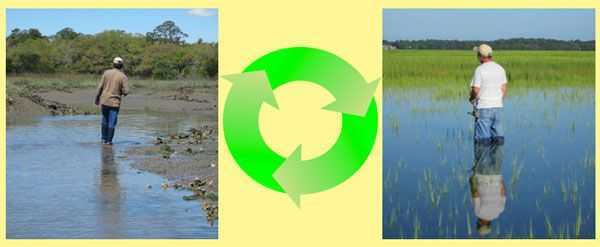Coastal fishermen throughout the United States are familiar with the influence that tides have on a successful day of fishing. On the Georgia Coast, anglers are exposed to the biggest tides on the East Coast south of Maine. The contour of the Georgia Coast creates a funnel effect that pushes an extreme amount of water into the marshes resulting in tides that can frequently exceed eight feet. This can often be overwhelming to anglers and boaters alike. Hopefully I can provide a little insight into understanding them and their influence on fishing.
It is important to have a working knowledge of the tide tables and how they are affected, particularly by the moon. In simplest terms, there is a tide change approximately 4 times in a 24 hour day. Each tide phase is actually closer to 6 hours, 12.5 minutes. The moon takes about 24 hours and 50 minutes to circle the earth, so the tides are 50 minutes later each day. This pattern will not change, which is why they’re are very predictable (if it is low tide on Monday at 7:00 a.m., it will be low tide on Tues. at 7:50 a.m.).
More importantly is understanding the influence that moon phases have on tide height. The moon takes approximately 30 days to circle the earth. During these 30 days, starting with the new moon (moon not visible), it will start filling up, or “waxing”. It will go to half visible (1st quarter) then to full, (full moon), to last quarter (half visible) and back to new. Each phase takes about 7 days, giving us the 30 day moon phase. While most of this is common knowledge, the key here is to know how each day of the moon phase affects the tides.
Here in the Golden Isles the average tide height is about 6.5 feet. When the moon is directly between the earth and sun (new moon), or directly behind the earth (full moon), they are the highest and lowest of the month. This can often mean that instead of moving 6.5 feet of water between high and low tide; we may now be moving as much as 9 or 10 feet of water during that 6 hour period. When those large amounts of water are moving in and out, (low to high, high to low), the current becomes much stronger, and the water becomes very turbid. Lack of water clarity can make fishing just plain tough! Conversely, around the 1st and last quarter, the tides will rise and fall at a much slower rate. These two tide stages on the new and full moon are called spring tides and the slower moving tides of the first and last quarter moon phase are called neap tides. There will be two spring tides and two neap tides every month. Naturally, during the slower moving tides, the water will be much cleaner. Fishing the Georgia Coast can be challenging with these wide fluctuations of tides and water conditions and in the next article I’ll actually talk about fishing and what helps me on all 30 days of the moon phase. While we all know you won’t know unless you go, you don’t always have the luxury of picking when you can go.
